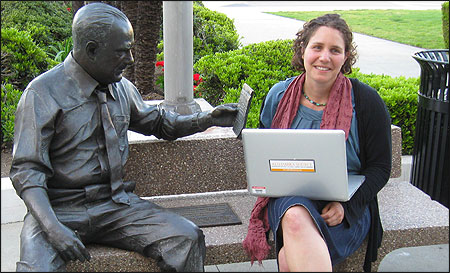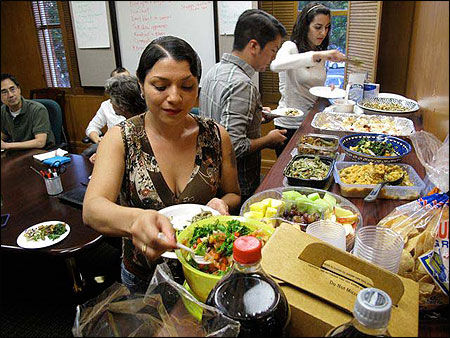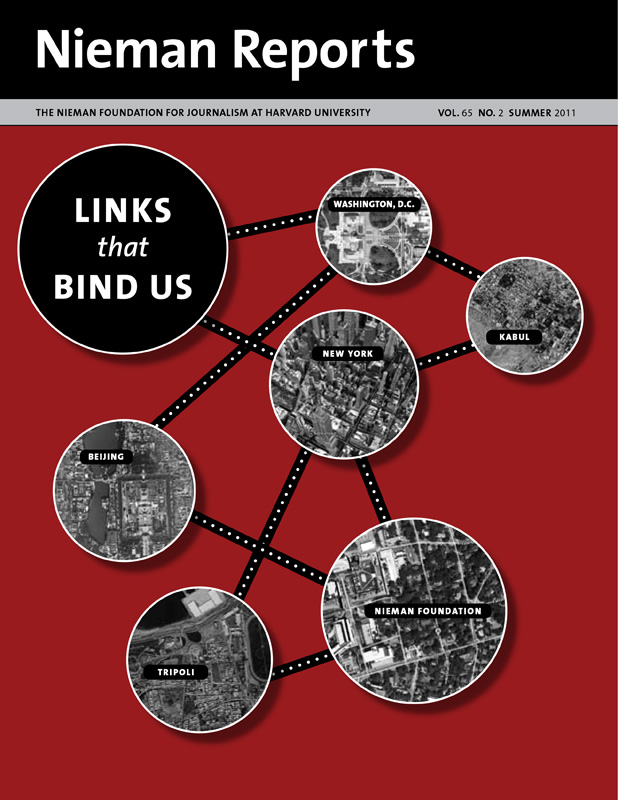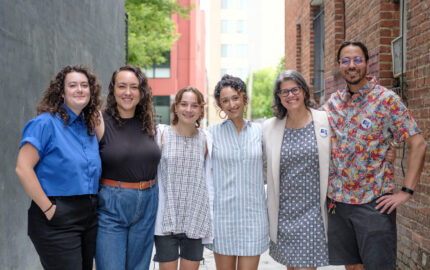
Present and past: Alhambra Source editor Daniela Gerson is a community journalist as was the late Warner Jenkins, editor of the now-defunct Alhambra Post-Advocate, whom the city honored with a statue. Photo by Tom Shea.
RELATED ARTICLE
“What We Learn Informs What We Do”
- Nancy ChenMunicipal elections were canceled last fall in Alhambra, California, a predominantly Asian and Latino city located about eight miles east of downtown Los Angeles. This is the first time that people there can remember this happening. City officials say this means that residents are satisfied; why else would no one have challenged any of the five incumbents on the city council and school board who were up for re-election? But many residents—the majority of whom are foreign born—are unaware of the city's governing processes.
Nor do they feel a strong sense of belonging to this place. One reason they might feel this way is the longtime absence of a single news source available to all of Alhambra's residents. On most days the closest any reporter comes to city hall is in the form of a life-sized bronze statue of the long-gone Alhambra Post-Advocate's editor. Linguistic barriers also limit the exposure of the reporting that does exist in English, Chinese or Spanish.
What's happening in Alhambra relates to the intersection of how information flows within a community and how people are engaged in civic-minded activities. For more than a decade this has been a core topic of research for Sandra Ball-Rokeach, a professor of communication at the University of Southern California's (USC) Annenberg School for Communication & Journalism, and her Metamorphosis team. In 2008 she teamed up with Michael Parks, former director of the school's journalism program and former editor of the Los Angeles Times, to look at how local news coverage could enhance civic engagement in Alhambra.
This academic project has since morphed into an experimental hyperlocal site called the Alhambra Source. The research afforded by the university and the expertise of Metamorphosis has been fundamental to the Source's early signs of success. With this research-based input, we grounded the website in the issues residents view as important.
Knitting Communities Together
With a background in immigration reporting—and with a smattering of community organizing skills including managing a Brooklyn farmers' market and running a small nonprofit magazine—I was hired nearly two years ago to take what the research was telling us and translate it into an online news source for the residents of Alhambra. The site would be, by necessity, multilingual, with stories focused on building community and overcoming ethnic barriers. Rather than rely on beats in the traditional sense, it would cultivate "communities of shared interest" that cut across ethnicity with topics such as food, schools and transit.
This is not a simple task. While hyperlocal news sites are common today, most serve relatively affluent, homogeneous communities. Alhambra is largely a lower middle-class suburban city of about 85,000 that has undergone tremendous demographic changes during the past 20 years. Residents—about 50 percent of whom are Asian, one third Latino, and 10 percent white—tend to self-segregate along ethnic lines.
Despite these challenges, in less than a year the Alhambra Source has revealed significant lessons about the power of journalism to build community in diverse and underserved areas. These relate to journalistic work we are doing that other communities could adapt. Two lessons, in particular, stand out:
- Even without full translation, there are important ways that news can have an impact that transcends language barriers.
- A volunteer team of community members, working with an experienced reporter, can influence what happens in a local community beyond what journalists on their own can accomplish.
We began with the goal of overcoming linguistic barriers. This meant the site needed to provide news in the three predominant languages spoken in the city: English, Chinese and Spanish. Realizing this goal presented serious challenges. We did not want to create three parallel sites on which individuals would read—and comment—in their respective languages and not interact. Moreover, while we had on our team Chinese and Spanish speakers as translators, keeping up with the demand for daily content was too much for our quite limited paid staff (me).
We are now in a beta stage for the multilingual site with static pages in three languages. USC students and volunteers provide translation into English of select Chinese and Spanish stories submitted by those in the community. These stories are then published in three languages in a single post. The entire site is also available with a rough translation via Google. With a local twist on an approach that New America Media, a collaboration of ethnic news organizations in the United States, has taken on a national level, we provide full summaries of all Alhambra coverage in addition to full translation of some Chinese- and Spanish-language reporting.
Before we launched, city administrators, police, teachers and education policymakers told us they could not read the Chinese press. This is a serious problem in a city with three active Chinese-language newspapers providing the bulk of local coverage—and I think it's fair to assume that Alhambra is not unique in this challenge. Despite the Source's limited format, the response to having stories available in three languages has been impressive, and it has created a bridge between what was thought of as "ethnic media" and local decision-makers.
In thinking about recruiting community contributors, we relied on the experiences of websites such as the Chi-Town Daily News, Oakland Local, and Sacramento Press. Like us, each of these news sites unites the community expertise of volunteers with the skills of a journalist. Having in-house knowledge about journalism turns out to be crucial in the production process. But equally critical are the in-person meetings and the organizing efforts that go into making the citizen part of this partnership work. I went out to speak with students at high schools and people in libraries, and I contacted active online users and people involved in nonprofit organizations. After my initial outreach, people started to come to us on their own—from all walks of life. Now more than 30 community contributors and youth reporters, who speak a total of eight languages, are actively involved; they range from engineers and stay-at-home moms to mechanics and students, and they range in age from teenagers to retirees.
Our monthly meetings—part potluck dinner, part journalism training, and part editorial meeting—rival in the richness of story ideas any newsroom meeting I've attended. We are able to offer nothing or very limited payment, but what we can provide is a platform and the opportunity to hone a contributor's voice and argument. And it's a rare opportunity for residents of varied backgrounds to get to know one another. After the first holiday dinner, I did not want to keep asking the volunteer contributors to bring dishes, which have ranged from Taiwanese stew to pad Thai to arroz con leche. But they voted for it, and I've found that sharing food at our meetings nurtures collaboration.

Cecilia Garcia, one of Alhambra Source’s community contributors, joins others at the publication’s monthly pot-luck dinner meeting. Photo by Javier Cabral.
Stories They Tell
The stories that community contributors have excelled at telling come from a personal perspective but also involve some reporting. Some of the more popular pieces have also shed light on the perceptions of and interactions between groups in Alhambra. Anthony Perez asked why at a high school that is largely Asian and Latino he was the only Hispanic in the school's student government out of 52 elected members. Nasrin Aboulhosn shared what it was like to grow up Lebanese in a community that is almost all Asian and Hispanic. Joe Soong produced a satirical piece about why Chinese residents might not put much faith in the traditional restaurant rating system. Inthava Bounpraseuth wrote about why as a young gay Asian man he chose to live in the relatively conservative city.
Zaiming Hu was the first writer to contact the Source about contributing in Chinese. She came to a contributor meeting and suggested a critique of a new public park with a giant arch, modeled on the Arc de Triomphe, in the middle of it. A few days later Hu, who runs a small Internet business, was out on the streets gathering opinions from other residents. The article she wrote—in Chinese and translated into English—was one of the most commented on stories last year. At another meeting, when a community contributor, who was a member of the predominantly white preservation group, wanted to write about the phenomenon of mini-mansions replacing historic homes, Hu provided another view. She could not understand why anyone would prefer an old house over a big, beautiful new one.
The contributors' varied voices and backgrounds enable the Alhambra Source to represent this diverse and dynamic city in a way that no traditional newsroom (or reporter) possibly could. What they are sharing is strengthening bridges of understanding and connection. What started as an effort that city officials sometimes referred to as angry bloggers who are not "real journalists" is taken increasingly seriously. When the next election occurs, as long as the Alhambra Source is still around, our online forum will be a place for community members to discuss and debate the issues. I have a strong feeling no incumbent will go unchallenged.
Daniela Gerson is the editor of the Alhambra Source. She has reported on immigration for newspapers and public radio, including the Financial Times Magazine, The New York Sun, and WNYC. She has received fellowships from the Alexander von Humboldt Foundation and the Institute for Justice and Journalism and was an Arthur F. Burns Fellow. She is a graduate of the inaugural class of the Specialized Journalism program at the University of Southern California's Annenberg School for Communication & Journalism.



